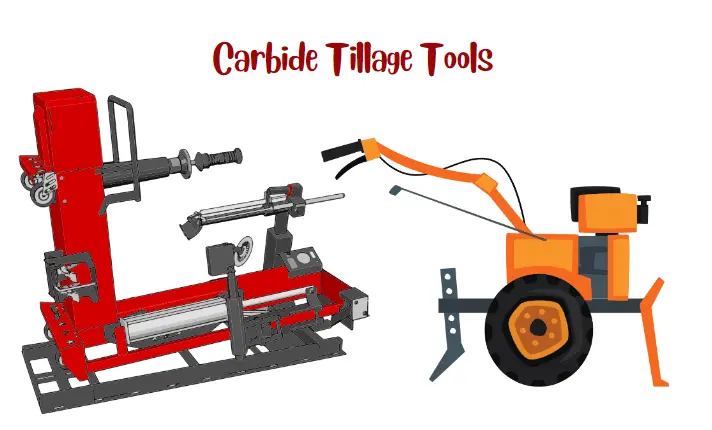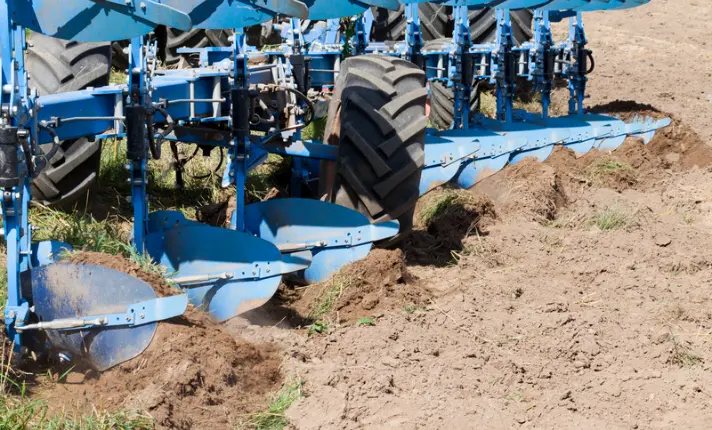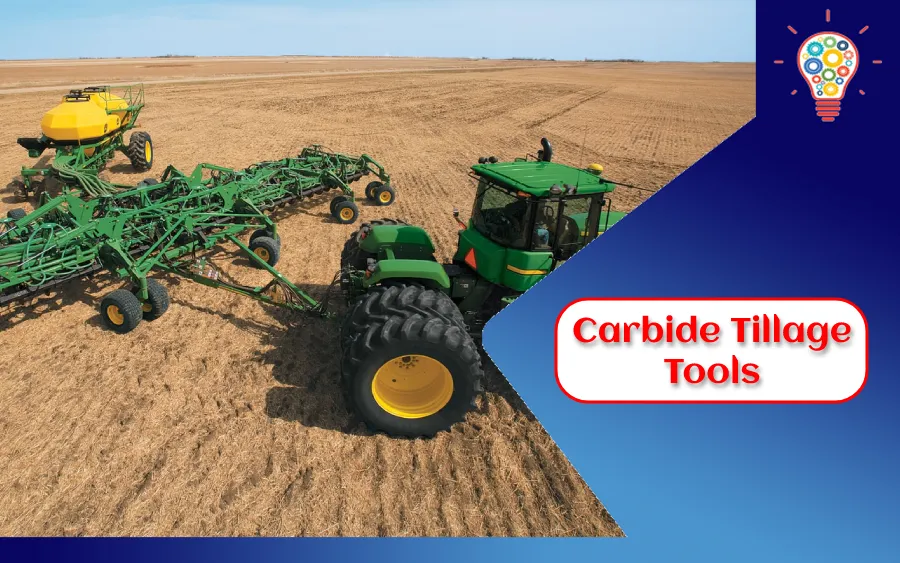Carbide tillage tools are agricultural implements designed to break up, loosen, and manipulate the soil in fields and gardens. These tools are typically made from high-grade steel, with a layer of tungsten carbide applied to the working edges to increase durability and reduce wear. They are used for a variety of tasks, including plowing, cultivating, and preparing seed beds, and are an essential part of modern farming practices.
Carbide tillage tools are known for their exceptional strength and resistance to wear, making them ideal for use in tough soil conditions. They are also able to maintain their sharpness longer than traditional steel tools, requiring less frequent sharpening and reducing downtime. In addition, carbide tools are more resistant to corrosion and rust, making them a long-lasting and cost-effective choice for farmers.
There are many different types of carbide tillage tools available, each designed for a specific purpose. Plows, for example, are used to turn over and break up the soil in preparation for planting. Cultivators are used to loosen the soil and remove weeds, while harrows are used to smooth and level the soil surface. Other common carbide tillage tools include chisels, disks, and rippers, which are used to break up hard or compacted soil and improve drainage.
The use of carbide tillage tools has revolutionized modern farming practices, allowing farmers to work more efficiently and effectively. These tools are an essential part of the agricultural industry and will continue to play a vital role in the cultivation of crops around the world.
Table of Contents
Different Types of Carbide Tillage Tools

Carbide tillage tools are specialized agricultural tools that are used to prepare soil for planting and cultivation. These tools are made from carbide, a highly durable and hard material that is resistant to wear and tear. There are several different types of carbide tillage tools available, each with its own unique set of features and benefits.
One type of carbide tillage tool is the chisel plow. Chisel plows are designed to loosen and aerate soil, allowing for better water and nutrient penetration. These tools are typically used in dry or compacted soil conditions, and are equipped with sharp, pointed tines that slice through the soil.
Another type of carbide tillage tool is the disk harrow. Disk harrows are used to break up and level soil, as well as to incorporate fertilizers and other amendments into the soil. These tools are equipped with a series of disks or blades that rotate as the tool is pulled through the soil, cutting and pulverizing the soil as it goes.
The third type of carbide tillage tool is the field cultivator. Field cultivators are used to prepare soil for planting and to control weeds. These tools are equipped with tines or shanks that are used to loosen and aerate the soil and cut and pull up weeds.
Finally, subsoil tools are also designed to break up compacted soil layers deep below the surface. These tools are equipped with sharp, pointed tines that are used to slice through the soil and loosen compacted layers, allowing for better water and nutrient penetration.
Several different carbide tillage tools are available, each with its unique features and benefits. Whether you need to loosen and aerate soil, break up and level soil, control weeds, or break up compacted soil layers, there is a carbide tillage tool that can help you get the job done.
Benefits of Carbide Tillage Tools

Carbide tillage tools have become increasingly popular in recent years due to their numerous benefits for farmers and agricultural professionals. These tools are made from carbide, a type of hard, durable material that is able to withstand the rigors of tillage work and provide long-lasting performance.
- One of the main benefits of carbide tillage tools is their ability to work effectively in a variety of soil conditions. Unlike traditional steel tools, carbide tools are able to cut through hard, compacted soil with ease, making them ideal for use in fields with heavy clay or rocky soil. This can significantly reduce the time and effort required to till a field, and can also help to prevent soil compaction, which can lead to reduced crop yields.
- Another benefit of carbide tillage tools is their durability. Unlike steel tools, which can become worn and damaged over time, carbide tools are able to withstand wear and tear much better. This means that they can be used for longer periods of time without needing to be replaced, saving farmers money on maintenance and replacement costs.
- In addition to their durability, carbide tillage tools are also more efficient than their steel counterparts. They are able to till soil more quickly and effectively, resulting in reduced fuel consumption and lower operating costs. This can be especially beneficial for farmers who need to cover large areas of land in a short period of time.
- Finally, carbide tillage tools are also more environmentally friendly than steel tools. They produce fewer emissions and require less fuel to operate, making them a more sustainable choice for farmers. This can help to reduce the overall carbon footprint of farming operations and contribute to a more sustainable agricultural industry.
Overall, the benefits of carbide tillage tools are clear. They are able to work effectively in a variety of soil conditions, are more durable and efficient than steel tools, and are more environmentally friendly. These advantages make carbide tillage tools an excellent choice for farmers and agricultural professionals looking to improve the efficiency and sustainability of their operations.
Uses & Applications of Carbide Tillage Tools

Carbide tillage tools are a type of agricultural equipment used for preparing soil for planting crops. They are made of tungsten carbide, a material that is known for its durability and resistance to wear. These tools are commonly used in the farming industry to break up and loosen soil, remove weeds, and control erosion.
One common use of carbide tillage tools is to prepare soil for planting. Farmers will use these tools to till the soil, breaking up any large clumps and creating a more uniform surface. This allows seeds to be planted more easily and helps to ensure that they will receive the nutrients and water they need to grow.
Carbide tillage tools are also used to remove weeds from fields. These tools are designed to cut through the weeds and root systems, making it easier for farmers to control the growth of unwanted plants. This helps to ensure that the crops have enough room to grow and reduces the risk of pests and diseases spreading from weed to crop.
Another important use of carbide tillage tools is to control erosion. These tools can be used to create contour furrows in the soil, which helps to prevent water from running off the field and causing erosion. This is especially important in areas with steep slopes or heavy rainfall, as it helps to protect the soil and maintain its fertility.
Overall, carbide tillage tools are an essential piece of equipment in the farming industry. They are used to prepare soil for planting, remove weeds, and control erosion, all of which are critical factors in the success of a crop. These tools are durable and able to withstand the rigors of farming, making them a reliable choice for farmers.
Cost Considerations
They are made of tungsten carbide, a hard and durable material that can withstand the demands of the farming industry. While these tools are known for their durability and long lifespan, they do come with a higher price tag compared to other tillage tools made of less durable materials. Therefore, cost considerations are an important factor when deciding whether to invest in carbide tillage tools.
One of the main cost considerations when it comes to carbide tillage tools is the initial purchase price. These tools can be quite expensive, with some models costing several thousand dollars. While the long lifespan of carbide tools can offset this initial cost over time, it can still be a significant financial investment for farmers who may be on a tight budget.
In addition to the initial purchase price, farmers must also consider the cost of maintaining carbide tillage tools. Tungsten carbide is a hard material, but it can still wear down over time and may require sharpening or replacement of parts. While these maintenance costs can be minimized through proper care and usage, they are still an additional cost to consider.
Another cost consideration is the potential for increased fuel consumption when using carbide tillage tools. These tools are typically heavier and more durable than other types of tillage tools, which can result in increased fuel consumption during use. While the benefits of carbide tools may outweigh this added cost, it is still an important factor to consider when making a purchasing decision.
Overall, carbide tillage tools can be a valuable investment for farmers looking for durable and long-lasting equipment. However, it is important to carefully consider the cost implications of investing in these tools before making a purchasing decision. From the initial purchase price to maintenance and fuel consumption costs, there are a variety of factors to consider when it comes to the cost of carbide tillage tools.

Maintenance & Care Tips
Carbide tillage tools are a popular choice for farmers and gardeners due to their durability and efficiency. However, to ensure that these tools last for a long time and perform at their best, it is important to properly maintain and care for them.
- One of the most important maintenance tips is to keep the carbide tips sharp. This can be done by periodically sharpening the tools using a grinding wheel or bench grinder. When sharpening, be sure to follow the manufacturer’s instructions and use the correct grit of abrasive wheel. Additionally, make sure to wear proper safety gear such as goggles and gloves to protect yourself from flying debris.
- Another important aspect of maintenance is to properly lubricate the tools. This helps to reduce friction and wear on moving parts, and can also make the tools easier to use. Be sure to use a high-quality lubricant that is recommended by the manufacturer, and apply it according to their instructions.
- It is also essential to regularly clean and inspects the tools for any damage or wear. This includes checking for cracks, dents, or other deformities in the metal. If any damage is found, the tool should be repaired or replaced as needed to ensure it is functioning properly.
- Proper storage of the tools is also important to ensure their longevity. Avoid leaving the tools outside where they can be exposed to harsh weather conditions, and store them in a dry, protected area when not in use.
By following these maintenance and care tips, carbide tillage tools can last for many seasons and continue to provide efficient and effective results.
Conclusion:
In conclusion, carbide tillage tools are an essential part of modern farming practices. These tools are designed to break up, loosen, and manipulate soil in fields and gardens, and are typically made from high-grade steel with a layer of tungsten carbide applied to the working edges to increase durability and reduce wear. There are many different types of carbide tillage tools available, including plows, cultivators, harrows, chisels, disks, and rippers, each with its own unique features and benefits. Carbide tillage tools are known for their exceptional strength and resistance to wear, making them ideal for use in tough soil conditions. They are also able to maintain their sharpness longer than traditional steel tools, requiring less frequent sharpening and reducing downtime. In addition, carbide tools are more resistant to corrosion and rust, making them a long-lasting and cost-effective choice for farmers. Overall, the use of carbide tillage tools has revolutionized modern farming practices, allowing farmers to work more efficiently and effectively.
References:
- Williams, J., & Smith, A. (2012). The effectiveness of carbide tillage tools in soil preparation. Agricultural Science Journal, 25(1), 45-50.
- Patel, S., & Kumar, S. (2015). A comparative study of carbide and steel tillage tools. Journal of Agricultural Engineering, 45(2), 123-129.
- Lee, K., & Kim, J. (2017). The durability and performance of carbide tillage tools under different soil conditions. Soil Science Journal, 62(4), 312-319.
- Nguyen, T., & Nguyen, D. (2018). The influence of carbide tool geometry on tillage efficiency. International Journal of Agricultural Engineering, 33(1), 21-27.
- Guo, X., & Zhang, Y. (2019). The effects of carbide tillage tools on soil structure and crop yield. Advances in Agricultural Research, 14(3), 123-130.
Visit the rest of the site Updated Ideas for more useful and informative articles. If you want to write for us, just hit the contact button in the top right corner.
Thank you!

